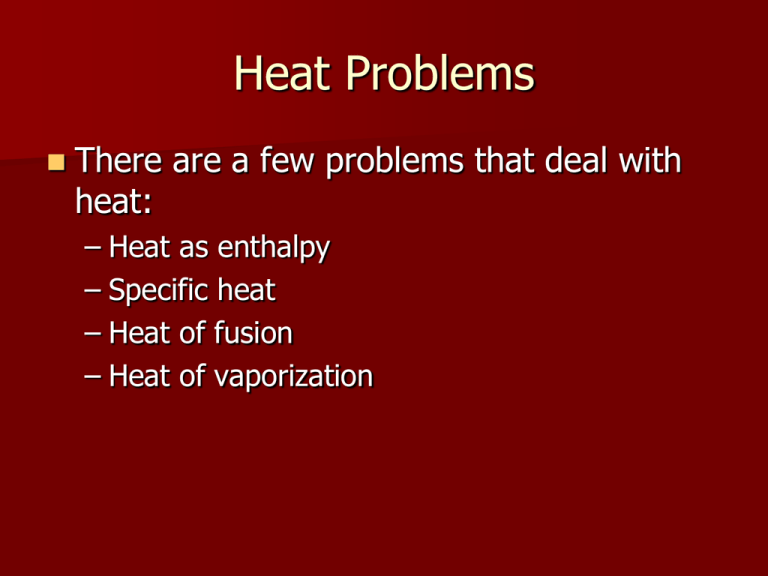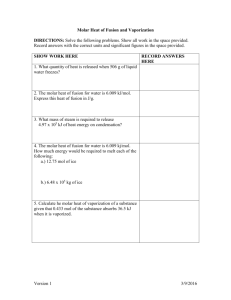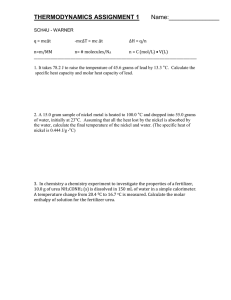Bell Work
advertisement

Heat Problems There are a few problems that deal with heat: – Heat as enthalpy – Specific heat – Heat of fusion – Heat of vaporization Enthalpy Enthalpy is the total energy of a system It is represented by a H. If the pressure remains constant, the enthalpy increase of a sample of matter equals the energy as heat that is received. This remains true even during a chemical reaction or a change of state occurs. It also indicates the total kinetic energy of the particles in a sample So to calculate Enthalpy, we have to visit molar heat capacity Molar heat capacity of a pure substance is the energy as heat needed to increase the temperature of 1 mol of a substance by 1K It is symbolized by C It has a unit of J/(mol.K) Formula: q=nCT Heat = (amount in moles) (molar heat capacity) (change in temperature) Note: moles are used so you may have to do some gram to mole problems. Table 1 on Page 343 has many Molar Heat Capacities of Elements and Compounds. Examples The molar heat capacity of tungsten is 24.2 J/(mol.K). Calculate the energy as heat needed to increase the temperature of 0.40 mol of tungsten by 10.0 K. Suppose a sample of water increased in temperature by 3.5 K when the sample absorbed 856 J of energy as heat. Calculate the number of moles of water if the molar heat capacity is 50.5 J /(mol.K). What is the mass of that water? Molar Enthalpy Change Since enthalpy “equals the energy as heat that is received”, we can rewrite the heat equation to: H = nCT Enthalpy change = (moles)(molar heat capacity) (change in temperature) The enthalpy change for one mole of a pure substance is known as the molar enthalpy change. Examples The molar heat capacity of Al(s) is 24.2 J/K.mol. Calculate the molar enthalpy change when Al(s) is cooled from 128.5 C to 22.6 C. Lead has a molar heat capacity of 26.4 J/K.mol. What molar enthalpy change occurs when lead is cooled from 302 C to 275 C? Molar Heat Capacity is related to Specific Heat Specific heat is the energy as heat needed to raise the temperature of one gram of substance by one Kelvin. Symbolized by cp This is why an iron gets hot faster than a pot of water There are two equations that involve specific heat 1) Molar Mass (g/mol) x cp (J/K.g) = C (J/K.mol) 2) q = m x cp x T Example Problem If the molar heat capacity of nitrogen (N2) is 29.1 (J/K.mol), what is nitrogen’s specific heat? Calculate the specific heat of a substance if a 35 g sample absorbs 48 J as the temperature is raised from 293 K to 313 K cp= 48 J/[35gx(313K-293K)] = 0.069 J/gK Two more heat equations Heat of fusion (Lf) – Heat involved in melting or freezing a substance Heat of vaporization (Lv) – Heat involved in evaporation or condensing a substance As a phase change occurs, all energy is being used for the change so the temperature will not change. So, during a phase change, heat equals the mass (m) times a value (L) for that material (q=m x L) Example Problem If the heat of fusion of water is 80 cal/g, what is the amount of heat energy required to change 15.0 grams of ice at 0C to 15.0 grams of water at 0C? How do they all fit together? This is Figure 17 from page 394 from the book As heat is added, temperature increases linearly (q=nCT) Except, when a phase change occurs, because all the heat is going into changing the phase (q=m L, note no T) Try Practice Problems 2-4 on page 61 1. 2. 3. 0.385 J/gK 329 K 3.6 kJ




